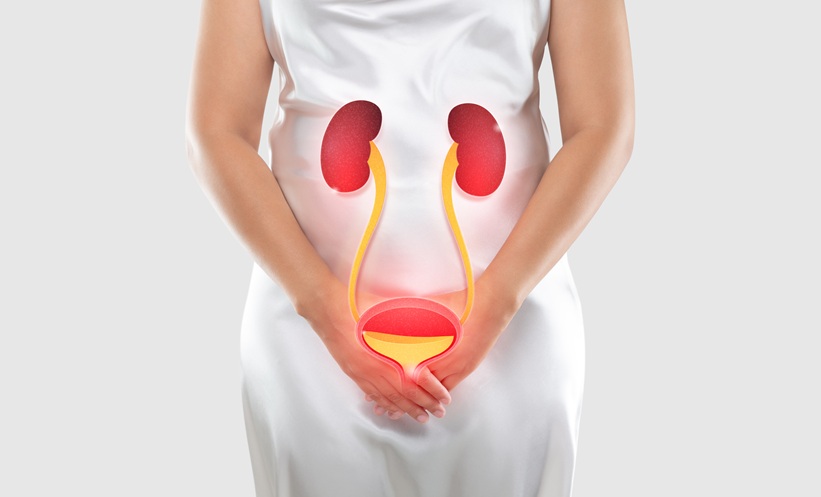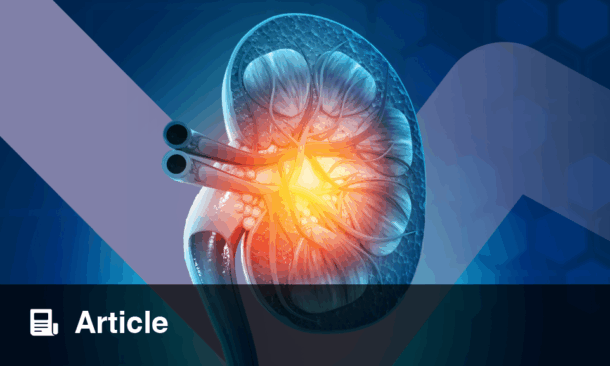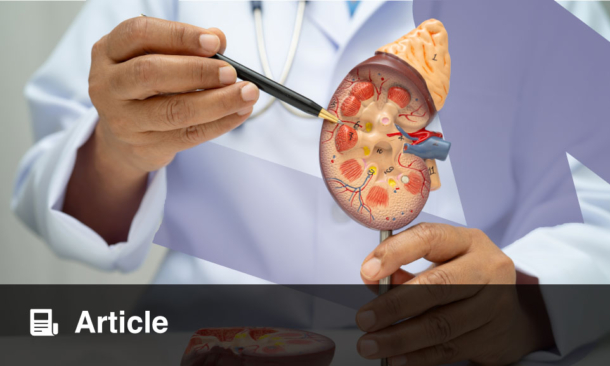Patrick Maxwell | Regius Professor of Physic and Head of the School of Clinical Medicine, University of Cambridge, UK
Citation: EMJ Nephrol. 2025;13[1]:53-57. https://doi.org/10.33590/emjnephrol/BSIU1559![]()
Nephrology continues to evolve rapidly, from molecular discoveries to new therapies. In your view, what makes this field so exciting and important today?
It has completely changed from when I started in nephrology, which was back in 1987. A much greater proportion of nephrology then was focused on acute renal failure. An attractive aspect compared to many medical specialties was that you could make an accurate diagnosis quickly, with blood tests, imaging, and renal biopsy. At that time, we had rather limited options to alter the course of disease. For example, when treating autoimmune conditions, we only had a few immunosuppressive therapies available. We often gave large doses, which caused major side effects, and often didn’t work very well. Even if we couldn’t reverse kidney damage, we had replacement therapies (dialysis and transplantation). We were mainly seeing younger people, and we could often help them quickly.
One change is that we now support a much wider population with chronic kidney disease (CKD), including many elderly patients and those with comorbidities. Some argue that this makes the specialty less interesting, but I find it more rewarding. There are so many more people we can help now. Over my career, nephrology has become more inclusive, and also more effective.
A second difference is that we are now much better at slowing the progression of CKD. Back then, we mostly just watched kidney function deteriorate and planned for dialysis. Today, we can slow progression in many people with CKD, and that’s improving all the time.
A third change is that knowledge about kidney diseases, especially autoimmune and genetic diseases, has increased enormously. This is leading to better approaches to diagnosis and treatment.
However, there is still a huge amount to do! For example, we still don’t really know how to improve recovery after acute kidney injury, and we still have a serious shortage of transplant organs. I believe that both of those issues will be solved in the coming years. I anticipate that we will learn how to stimulate the kidneys’ ability to repair and regenerate.
Your pioneering research on hypoxia-inducible factors (HIF) has shaped our understanding of oxygen sensing. How did your interest in this area begin, and what do you see as its most significant impact on nephrology?
My first nephrology training post was in 1987 at Hammersmith Hospital in London, UK. At that time, they were doing the first human studies with recombinant erythropoietin (EPO). Kidney patients were often anaemic and needed regular blood transfusions, which carried all kinds of risks, such as infection and immune sensitisation, which makes transplantation more difficult. Most patients were chronically anaemic and tired.
EPO had been identified as a kidney-produced hormone that was relatively deficient in people with kidney disease. So, it was produced as a recombinant drug. Strikingly, in these early studies, it worked. Patients felt better, and as long as the haemoglobin wasn’t increased too rapidly, it was safe and well tolerated.
Emerging knowledge about EPO raised fascinating questions. If you are very anaemic, then your kidneys can increase EPO production by 10,000-fold. So, which cells are producing it? How do they know how much oxygen is reaching them? And why does this process go wrong in kidney disease?
I joined Peter Ratcliffe’s group in the Institute of Molecular Medicine at the University of Oxford, UK, to work on this in 1991. We set out to find the cells that produce EPO, and how they sense oxygen. Over the next 11 years, we solved those problems. At the time, HIF hadn’t yet been identified. My early experiments showed that oxygen sensing happens in every cell we tested, which suggested that it had functions beyond regulating EPO. We now know that the underlying system, HIF, regulates thousands of genes and is active in every cell all the time.
We also discovered that fibroblasts in the kidney produce EPO. These were not the cells that people had expected. It was surprising because fibroblasts were thought to be quite boring, but from a design perspective, they are well placed to be reliable monitors, situated between the capillaries that are supplying the oxygen and the tubular cells that are using it.
We found that these cells are still present in people with CKD and can still produce EPO, though aspects of the disease processes alter that ability.
The implications of the discoveries made go far beyond nephrology. HIF research has been especially important in cancer. Tumours often grow in low-oxygen environments, and the HIF pathway is critical in how they behave. It is particularly important in adapting their metabolism and driving signals for new blood vessel growth.
In nephrology specifically, we later discovered that HIF-2 activation is the key genetic event in the most common form of kidney cancer, clear cell renal carcinoma. That was completely unexpected. It involves different cells (tubular epithelial cells rather than fibroblasts) and reveals something fundamental about how kidney cells behave under low oxygen.
Clinically, the research led to new treatments for anaemia in kidney disease. Instead of injecting EPO, we can now give tablets that stimulate its production. There are about six such drugs in patients globally now. They’re cheaper, easier to administer, and, in some cases, may be even better than EPO.
The discovery of prolyl hydroxylase domain (PHD) enzymes opened up new therapeutic avenues. How do you reflect on the journey from that basic science discovery to the development of HIF stabilisers that are now used clinically?
A first reflection is that it’s impressive how quickly this went from discovery to therapy. We identified the enzymes in 2002, and within a decade, companies developed drugs that could be used in patients. These were compared to EPO and found to be as effective, sometimes safer, sometimes not, depending on the drug and the setting.
A second reflection is that, although using these drugs has superficial similarity to using EPO, in that they boost red blood cell production, they’re completely different. EPO is specific and acts on a cognate receptor. With PHD inhibitors, you’re activating a whole system that affects thousands of genes. That complexity has pros and cons. On the positive side, because HIF activation helps cells survive low oxygen, they could reduce the severity of heart attacks or strokes in patients, but it might also increase the risk of cancer or speed up tumour progression.
A third reflection is that we learned a lot from studying humans with natural mutations in this pathway. People with certain HIF or PHD variants resulting in mild HIF activation have higher red blood cell counts but no major problems, suggesting that activating the pathway is relatively safe. In contrast, in von Hippel Lindau (VHL) disease, both copies of the VHL gene are affected in occasional cells throughout the body. This results in genetic HIF activation in those cells, with serious consequences, including a very high lifetime risk of kidney cancer; thus, dosage and targeting matter.
What I find slightly disappointing is that these drugs have mainly been tested as EPO replacements. Their real potential may be in treating conditions such as acute kidney injury, stroke, or heart attack. In animal studies, they look very promising, but we still lack good clinical trials in those areas.
Currently approved HIF stabilisers inhibit all three PHD enzymes. Over time, it may be attractive to selectively inhibit one of them, like PHD3 but not PHD2, which could be more beneficial in certain diseases. That’s still an open question.
Are there any novel biomarkers or targets emerging from the hypoxia pathway that you believe could change how we monitor or manage kidney disease?
Not at the moment, but I think there’s a lot of potential, particularly in the area of kidney repair and regeneration. We don’t yet have markers that can show us how well the kidneys are repairing themselves.
It would be fantastic if we could take a urine sample and assess the regenerative state of the kidney cells. That would give us a whole new window into what’s happening and how to intervene earlier or more effectively.
Beyond hypoxia, what other molecular pathways or mechanisms excite you the most in the context of kidney disease research today?
I’m very interested in the complement system. We studied families with kidney disease and discovered a mutation in a complement factor H-related protein. This mutation is very common among Cypriots, and can cause kidney disease by subtly altering the complement pathway.
It looks very similar to IgA nephropathy, which is a common condition. Until recently, there weren’t many effective treatments for IgA nephropathy, but now new therapies are emerging that target IgA deposition and the complement response. More broadly, complement activation plays a role in many kidney diseases and transplant rejection. We now understand this pathway well enough to develop targeted interventions, and I think that’s incredibly exciting.
Another area is immune responses to kidney proteins. In minimal change nephropathy, for example, it looks like we might now know which protein is being targeted by the immune system. That could revolutionise how we treat it. Back in the 1980s, we just gave high-dose steroids to everyone because we didn’t know who would respond. It usually worked, but the side effects and dealing with recurrences made it very challenging for many patients. With more understanding, we can do much better.
Translating scientific discoveries into therapies is not very straightforward. What do you see as the biggest challenges and opportunities in bringing cutting-edge kidney research to the bedside?
First, you need a solid understanding of the disease and the pathways involved. Then, you need measurable indicators, ideally things you can track reliably and repeatedly.
A challenge in nephrology is that, by the time kidney function is measurably reduced, a lot of irreversible damage has already occurred. We need earlier markers to tell whether our interventions are making a difference before serious harm has occurred.
Another challenge is infrastructure. Most clinical settings are good at patient care but lack the time and resources for research, taking extra samples, running additional tests, or explaining studies to patients.
We also need a workforce trained in research. I was fortunate to get a Medical Research Council fellowship to do my PhD in Oxford, UK, and that gave me proper scientific training and changed my career.
Here at our medical school, every student does the equivalent of an intercalated science degree. That gives them a strong foundation for understanding research over the course of their career.
And finally, reflecting on your journey so far, what factors do you think have been essential to driving impactful research in nephrology?
I think there are three things. First, where I worked, I had the privilege of training in units where research was happening and where people were changing the future of nephrology. That environment is vital.
Second, inspiring individuals. These included Stuart Cameron (Guy’s Medical School, now part of King’s College London, UK), Chris Winearls (Hammersmith and Royal Postgraduate Medical School, now part of Imperial College London, UK), and Peter Ratcliffe (University of Oxford, UK), who all made major contributions to the field and inspired me personally. Science is a team effort, but individuals can have a huge impact.
Third, the patients. Most kidney patients stay with us for life. You build long-term relationships with them, and that creates a real partnership. Patients with VHL, complement factor H-related protein 5 (CFHR5) nephropathy, and polycystic kidney disease have all inspired me and helped drive my research. That shared understanding makes the doctor–patient relationship stronger and makes research more impactful.
My final point is this: nephrology is a specialty where I believe the NHS approach works well. There’s very little private medicine in nephrology. We can’t have long waiting lists because kidney function can decline quickly, and renal failure is an emergency. In general, care is delivered equally and promptly, which I think is a huge strength of the specialty.






